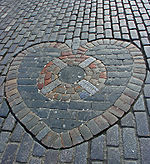This is an old revision of this page, as edited by Gurch (talk | contribs) at 09:23, 1 April 2006 (no, that doesn't make sense. perhaps it should be "millennium"?). The present address (URL) is a permanent link to this revision, which may differ significantly from the current revision.
Revision as of 09:23, 1 April 2006 by Gurch (talk | contribs) (no, that doesn't make sense. perhaps it should be "millennium"?)(diff) ← Previous revision | Latest revision (diff) | Newer revision → (diff)
The Royal Mile is the popular name for the succession of streets which form the main thoroughfare of Edinburgh's Old Town. As the name suggests, it was equivalent to a Scottish mile between the two foci of royal history in Scotland, from Edinburgh Castle at the top of the Castle Rock down to the Palace of Holyroodhouse. Along the way, the actual name of the street changes from Castle Esplanade to Castlehill, to Lawnmarket, to High Street, to Canongate, and finally to Abbey Strand. The Royal Mile is Edinburgh's busiest tourist street, rivalled only by Princes Street in the New Town.
Geography
Retreating ice sheets, about a millennium ago, deposited their glacial debris behind the hard volcanic plug, that is Castle Rock (which Edinburgh Castle sits upon), resulting in a distinctive crag and tail feature. Extending in an eastwards direction, the Royal Mile sits upon the spine of this crag and tail trailing gently down from the Castle to the Palace of Holyroodhouse. Steep closes (or alleyways) run between the many tall lands (or tenement buildings) off the main thoroughfare, many of which give way to large courtyards.
Castle Esplanade and Castlehill
The Castle Esplanade was laid out in the 19th century primarily as a parade ground for troops. It is the venue of the annual Edinburgh Military Tattoo. Cannonball House is notable for a cannonball lodged in the wall, said to have been accidentally fired from the Castle.
From the Castle Esplanade, the short Castlehill is dominated by the former Tolbooth Highland St John's Church (on the right), now the headquarters of the Edinburgh International Festival society - The Hub. The General Assembly Hall of the Church of Scotland and New College are on the left.
Lawnmarket
The Lawnmarket, which was the linen market, is dominated by tourist-oriented shops. On the left is the preserved 17th century townhouse Gladstone's Land owned by the National Trust for Scotland. The bottom of the Lawnmarket is marked by a major intersection with George IV Bridge on the right (south) and Bank Street on the left, leading to The Mound and the New Town. The view down Bank Street is dominated by the baroque headquarters of the Bank of Scotland.
High Street
During the annual Edinburgh Festival, the High Street becomes the city's central focus, and is crowded with tourists, entertainers and buskers. On the left is the High Court of Justiciary, Scotland's top criminal court. On the right, about one-third of the way down from the Castle toward the Palace is Parliament Square, named after the old Parliament House which housed both the law courts and the old Parliament of Scotland between the 1630s and 1707 (when it was dissolved by the Act of Union) Parliament House is still the home of the Court of Session, Scotland's top civil court. St Giles Cathedral, the High Kirk of Edinburgh, also stands in Parliament Square.

By the West Door of St Giles is the Heart of Midlothian, a heart-shaped mosaic built into the pavement marking the site of the former Tolbooth (prison). Tolbooth prisoners used to spit as they entered the prison, and this tradition is maintained by some people, who spit on the Heart for good luck as they walk past. On the left, opposite St Giles', is Edinburgh's City Chambers, where the City of Edinburgh Council meets. On the right, just past the High Kirk, is the Mercat Cross from which royal proclamations are read.
A little further down the Royal Mile, near its midpoint, is another major intersection from which a street called North Bridge runs left (north) to the New Town across Waverley station; to the right, called instead South Bridge, it spans across the Cowgate, a street many storeys below, and continues past the Old College building of the University of Edinburgh. North Bridge and South Bridge together are usually known in Edinburgh as The Bridges.
Down from John Knox's House the High Street reaches the junction with St Mary's Street and Jeffrey Street. At this point formerly stood the old Netherbow, a fortified gateway to Edinburgh (long since demolished). The recently rebuilt Netherbow theatre is owned by the Church of Scotland and houses the Scottish Storytelling Centre. Following the English victory over the Scots at the Battle of Flodden in 1513, a city wall was built around Edinburgh known as the Flodden Wall, some parts of which still survive. The old Netherbow was a gateway in this wall and brass studs in the road mark where it use to stand. On the right is the World's End Pub (even though it only marks the end of the High Street).
Canongate
At this point the Royal Mile becomes the Canongate, meaning the canon's gait or monk's walk. It continues downhill past Moray House (now the School of Education of the University of Edinburgh), the old Canongate Tolbooth (now a museum of social history called The People's Story), the Kirk of the Canongate (the Canongate's parish church) and the new Scottish Parliament Building to the Palace of Holyroodhouse and the ruined Holyrood Abbey. Until 1856 the Canongate was a burgh in its own right, separate from Edinburgh (and not enclosed by the Flodden Wall).
Abbey Strand
The short approach to the Palace of Holyroodhouse.
Royal Mile today
Today, the Royal Mile is an ecletic mix of tourist shops and eateries as well as pubs and historical attractions. It also serves as the heart of Scotland's legal system